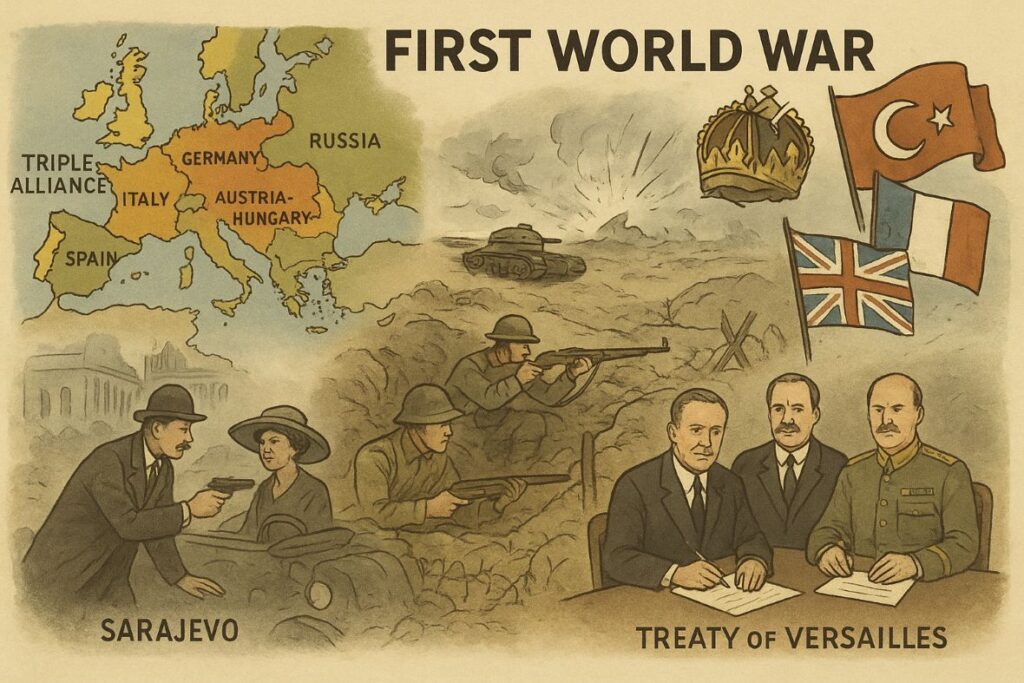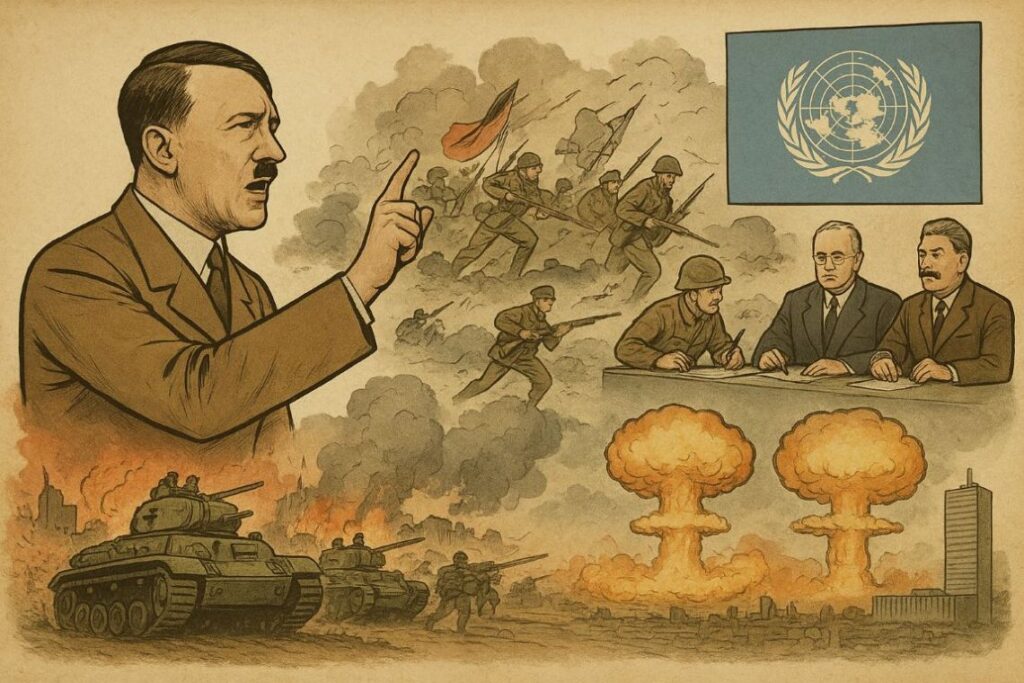1st PUC History Question and Answer – World Wars
International organisations
Looking for 1st PUC History textbook answers? You can download Chapter 10: World Wars International organisations Questions and Answers PDF, Notes, and Summary here. 1st PUC History solutions follow the Karnataka State Board Syllabus, making it easier for students to revise and score higher in exams.
Karnataka 1st PUC History Textbook Answers—Reflections Chapter 10
World Wars International organisations Questions and Answers, Notes, and Summary
1st PUC History Chapter 10
World Wars
International organisations
Scroll Down to Download World Wars International organisations PDF
I. Answer in a word or one sentence
Question 1.
When did the First World War break out?
Answer
The First World War broke out in 1914.
Question 2.
Who was the Emperor of Germany during the First World War?
Answer
The Emperor of Germany during the First World War was Kaiser William II.
Question 3.
Mention the immediate cause for the First World War.
Answer
The immediate cause for the First World War was the assassination of Archduke Franz Ferdinand of Austria.
Question 4.
Why did U.S.A. join the First World War?
Answer
The U.S.A. joined the First World War because Germany sank American ships.
Question 5.
Which conference officially ended the First World War?
Answer
The Paris Peace Conference officially ended the First World War.
Question 6.
Who was the founder of Fascism?
Answer
The founder of Fascism was Benito Mussolini.
Question 7.
What is the meaning of the word ‘Fascism’?
Answer
The word ‘Fascism’ means a bundle of rods with an axe (symbol of authority).
Question 8.
Name the paper edited by Mussolini.
Answer
The paper edited by Mussolini was Avanti (later also Il Popolo d’Italia).
Question 9.
Who declared, ‘Italy must expand or perish’?
Answer
The statement ‘Italy must expand or perish’ was declared by Mussolini.
Question 10.
Where was Adolf Hitler born?
Answer
Adolf Hitler was born in Austria.
Question 11.
Who was the founder of Nazism?
Answer
The founder of Nazism was Adolf Hitler.
Question 12.
Mention the book written by Hitler.
Answer
The book written by Hitler was Mein Kampf.
Question 13.
Name the German Parliament.
Answer
The German Parliament was called the Reichstag.
Question 14.
What is Gestapo?
Answer
Gestapo was the secret state police of Nazi Germany.
Question 15.
Why did U.S.A. join the Second World War?
Answer
The U.S.A. joined the Second World War because Japan attacked Pearl Harbour on 7th December 1941.
Question 16.
Who ordered American Air Force to drop atom bombs on Japan?
Answer
President Harry S. Truman ordered the American Air Force to drop atom bombs on Japan.
Question 17.
When was Israel created for the Jews?
Answer
Israel was created for the Jews in 1948.
Question 18.
When was the U.N.O. established?
Answer
The U.N.O. was established in 1945.
Question 19.
Which day is celebrated as U.N. Day?
Answer
24th October is celebrated as U.N. Day.
Question 20.
Where is the Headquarters of U.N.O.?
Answer
The Headquarters of the U.N.O. is in New York, USA.
Question 21.
How many member nations are there in the U.N.O. at present?
Answer
At present, the U.N.O. has 193 member nations.
Question 22.
Where is the International Court of Justice?
Answer
The International Court of Justice is at The Hague, Netherlands.
Question 23.
Who is the present Secretary-General of the U.N.O.?
Answer
The present Secretary-General of the U.N.O. is António Guterres.
Question 24.
Expand (Any one) – ECOSOC, ILO, FAO, UNESCO, IBRD, IMF, WHO, WTO.
Answer
- ECOSOC – Economic and Social Council
- ILO – International Labour Organization
- FAO – Food and Agriculture Organization
- UNESCO – United Nations Educational, Scientific and Cultural Organization
- IBRD – International Bank for Reconstruction and Development
- IMF – International Monetary Fund
- WHO – World Health Organization
II. Answer in two words or two sentences:
Question 1.
Name the two rival alliances formed during the First World War.
Answer
The two rival alliances were the Allied Powers and the Central Powers.
Question 2.
Name the Treaty signed by the Allied countries with Germany. When was it signed?
Answer
The Treaty of Versailles was signed on 28th June 1919.
Question 3.
Mention the four empires which were overthrown after the First World War.
Answer
The German, Austrian, Russian, and Ottoman Empires were overthrown.
Question 4.
When was the League of Nations established? Where was its headquarters?
Answer
The League of Nations was established in 1920, with headquarters at Geneva.
Question 5.
Write any two principles of Fascism.
Answer
Extreme nationalism and one-party dictatorship were two principles of Fascism.
Question 6.
Write any two principles of Nazism.
Answer
Racial superiority and anti-Semitism were two principles of Nazism.
Question 7.
Name the two rival Powers of the Second World War.
Answer
The two rival powers were the Allied Powers and the Axis Powers.
Question 8.
Name the Axis Powers.
Answer
The Axis Powers were Germany, Italy, and Japan.
Question 9.
Name the Allied Powers.
Answer
The Allied Powers were Britain, France, USA, and USSR.
Question 10.
Name the cities of Japan where the atom bombs were dropped during the Second World War.
Answer
Atom bombs were dropped on Hiroshima and Nagasaki.
Question 11.
Write any two aims of the U.N.O.
Answer
To maintain peace and to promote international cooperation.
Question 12.
Name any two official languages of the U.N.O.
Answer
Two official languages are English and French.
Question 13.
Mention the five permanent members of the Security Council.
Answer
The five permanent members are U.S.A., U.K., France, Russia, and China.
Question 14.
What is ‘Veto’ power?
Answer
‘Veto’ power is the right to reject any decision of the Security Council.
III. Answer in 15 to 20 sentences.
Question 1.
Describe the various results of the First World War.
Answer
The First World War, which lasted from 1914 to 1918, brought far-reaching political, social, and economic changes. Nearly 10 million soldiers lost their lives, and millions were wounded. Politically, four great empires – German, Austrian, Russian, and Ottoman – collapsed, leading to the rise of new nations like Poland, Czechoslovakia, and Yugoslavia. The war also resulted in the downfall of monarchies in Germany, Austria, and Russia, paving the way for democratic governments. Economically, the war caused heavy destruction of industries, agriculture, and trade, leaving Europe in financial crisis.
The USA emerged as the strongest economic power, replacing Europe in world trade. Socially, the war brought untold misery, loss of lives, and spread of poverty and unemployment. It also created hatred among nations, which later led to the rise of dictatorships in Italy and Germany. The League of Nations was formed to prevent future wars, though it proved weak. The Treaty of Versailles sowed seeds of discontent, especially in Germany. The First World War thus changed the balance of power in the world, weakened Europe, and prepared the ground for the Second World War.
Question 2.
Explain the provisions of the Treaty of Versailles.
Answer
The Treaty of Versailles was signed on 28th June 1919 between Germany and the Allied Powers. It imposed very harsh and humiliating terms on Germany. Politically, Germany had to surrender Alsace and Lorraine to France, and give away territories like Eupen and Malmedy to Belgium, and Schleswig to Denmark. The Saar Valley was placed under the League of Nations. All German colonies in Africa and Asia were taken away and distributed among the Allied powers as mandates. Militarily, the German army was reduced to only 1,00,000 soldiers, and it was not allowed to maintain navy, air force, or submarines.
Economically, Germany was made to pay huge war reparations of 33 billion dollars to the Allies. It was also forced to accept the War Guilt Clause, taking full responsibility for the war. The Rhineland was to be demilitarized and occupied by Allied troops. These provisions weakened Germany politically and economically, and humiliated its people. The Treaty of Versailles, instead of ensuring peace, created bitterness in Germany, which later helped Hitler and the Nazis rise to power.
Question 3.
Describe the achievements of Mussolini.
Answer
Benito Mussolini, the founder of Fascism, became the Prime Minister of Italy in 1922 and ruled till 1943. He restored law and order in Italy by suppressing strikes and protests. Mussolini improved Italy’s economy by developing industries, agriculture, and trade. He started large-scale land reclamation projects like the “Battle for Land” and encouraged self-sufficiency in food through the “Battle for Grain.” He modernized the transport and communication system by constructing roads, railways, and canals. In foreign policy, he followed the slogan “Italy must expand or perish,” and tried to restore the glory of the Roman Empire. He conquered Ethiopia in 1936 and Albania in 1939.
Mussolini also improved relations with the Pope through the Lateran Treaty of 1929, which recognized Vatican City as an independent state. He introduced educational reforms and inspired national pride among Italians. Mussolini’s dictatorship gave Italy stability, but his aggressive policies dragged Italy into the Second World War on the side of Germany, which ultimately led to his downfall.
Question 4.
Explain the features of Nazism.
Answer
Nazism was the political ideology established by Adolf Hitler in Germany after the First World War. It was based on extreme nationalism and racial superiority. The Nazis believed in the supremacy of the Aryan race and hatred of Jews, whom they blamed for Germany’s problems. The ideology emphasized dictatorship, one-party rule, and blind obedience to the leader or “Führer.” Militarism and expansion were central features, as Hitler wanted to build a strong army and expand Germany’s territory. Nazism opposed democracy, communism, and liberalism.
It propagated the idea of “Lebensraum” (living space), demanding more land for Germans. The Nazis used propaganda effectively to control public opinion through media, schools, and rallies. Hitler also abolished trade unions, controlled industries, and promoted state control of the economy. Nazism glorified war and violence, and considered individuals as subordinate to the state. It led to terrible consequences, including persecution of Jews, concentration camps, and ultimately, the Second World War.
Question 5.
State the results of the Second World War.
Answer
The Second World War, fought from 1939 to 1945, had devastating results worldwide. Nearly 60 million people were killed, and many cities were destroyed. Politically, Germany, Italy, and Japan were defeated, and dictators like Hitler and Mussolini were overthrown. Germany was divided into four zones of occupation under the Allied powers. Italy became a republic, and Japan was forced to adopt a democratic constitution. Economically, the war caused massive destruction of industries, agriculture, and trade. The USA and USSR emerged as superpowers, while Europe lost its dominant position in world politics. Socially, the war created untold misery, with millions of people becoming refugees and suffering starvation.
The Holocaust shocked the world and revealed the horrors of Nazism. The use of atomic bombs on Hiroshima and Nagasaki demonstrated the destructive power of nuclear weapons. The League of Nations failed, but the United Nations Organization (U.N.O.) was established in 1945 to promote peace and cooperation. The war also led to the beginning of the Cold War between the USA and USSR.
Question 6.
Write a note on the Organs of the U.N.O.
Answer
The United Nations Organization (U.N.O.), established in 1945, has six main organs to achieve its objectives. The General Assembly is the central body where all member nations are represented, and it discusses international issues and makes recommendations. The Security Council is responsible for maintaining peace and security, and it has five permanent members with veto power – USA, UK, France, Russia, and China. The Economic and Social Council (ECOSOC) works to promote economic development, social progress, and human rights.
The Trusteeship Council was created to supervise trust territories and help them achieve independence. The International Court of Justice (ICJ), located at The Hague, settles disputes between nations and gives advisory opinions. The Secretariat, headed by the Secretary-General, carries out the day-to-day work of the U.N.O. and implements its programs. Together, these organs work to maintain peace, promote cooperation, and solve global problems.
IV. Answer in 30 to 40 sentences.
Question 1.
Explain the causes and results of the First World War.
Answer:
The First World War (1914–1918) was caused by many political and military factors. The main causes were aggressive nationalism, where countries like Germany and France competed for power, and militarism, as nations built huge armies and navies. Imperialism created rivalry for colonies in Africa and Asia. The formation of alliances divided Europe into the Triple Alliance (Germany, Austria, Italy) and the Triple Entente (Britain, France, Russia). The Balkan problem further increased tension. The immediate cause was the assassination of Archduke Francis Ferdinand of Austria in 1914, which triggered a chain of war declarations.
The results were disastrous. Nearly 10 million people died and Europe faced heavy destruction. The German, Austrian, Russian, and Ottoman Empires collapsed. New nations like Poland, Czechoslovakia, and Yugoslavia were created. The Treaty of Versailles imposed harsh terms on Germany, creating anger that led to the rise of Hitler. Economically, Europe became weak while the U.S.A. emerged as a world power. The League of Nations was established to prevent wars, but it later failed. The war completely changed the political map of Europe and sowed the seeds for the Second World War.
Question 2.
Explain the causes and results of the Second World War.
Answer:
The Second World War (1939–1945) was more destructive than the first. Its causes included the Treaty of Versailles, which humiliated Germany, and the rise of dictatorships under Hitler in Germany and Mussolini in Italy. Hitler’s policy of aggression and expansion threatened world peace. The failure of the League of Nations to stop aggression in Ethiopia and China encouraged dictators. The formation of Axis and Allied alliances created tension. Britain and France followed a policy of appeasement, allowing Hitler to expand. The immediate cause was Germany’s invasion of Poland in 1939, after which Britain and France declared war.
The results were terrible. Over 50 million people died. Dictatorships in Germany, Italy, and Japan ended. Germany was divided into East and West, and Japan was occupied by the U.S.A. The United Nations Organization (UNO) was formed to maintain peace. Economically, Europe was devastated, while the U.S.A. and USSR became superpowers, leading to the Cold War. The use of atomic bombs on Hiroshima and Nagasaki showed the dangers of nuclear weapons. Colonies in Asia and Africa began movements for independence. The Holocaust exposed Nazi cruelty. Thus, the Second World War reshaped global politics and international relations.
Question 3.
Describe the political and non-political achievements of the U.N.O.
Answer :
The United Nations Organization (UNO) was established in 1945 to maintain world peace. Its political achievements include preventing a Third World War and settling disputes in Korea, Congo, and the Middle East. It sent peacekeeping forces to many regions. The UNO worked for disarmament and supported decolonization, helping many countries in Asia and Africa gain independence. It also promoted human rights and democracy through its charters.
In non-political fields, the UNO made great contributions through its agencies. WHO worked to fight diseases like malaria and polio. UNESCO promoted education, culture, and science. FAO improved agriculture and food supply. UNICEF protected children’s welfare. ILO improved labor rights. The UNO also provided aid to refugees, supported women’s rights, and worked on environmental protection. The Universal Declaration of Human Rights (1948) is one of its greatest achievements.
Thus, the UNO has played a vital role in both peace and development. Despite challenges, it remains the most important international body for world cooperation.


